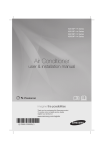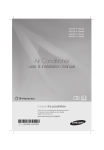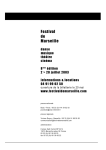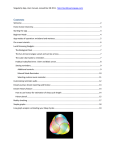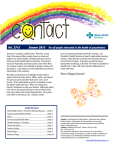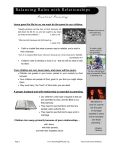Download Philips Wake-up Light HF3550
Transcript
Wake-up App: Content of Help pages 1. Take the tour 1a. Welcome 1b. Wake up 1c. Fall asleep 1d. Stats 2. The Wake-up Light 2a. How it works 2b. Wake-up function 2c. Fall asleep function 2d. The light source 2e. Optimize your settings 2f. Troubleshooting 2g. Where can I get one? 3. Wake-up Stats 3a. Why this feature 3b. What is measured 3c. How to use the results 3d. Healthy bedtime routines 4. Well-being by light 4a. Light and a healthy lifestyle 4b. Light and alertness 4c. Light and sleep 4d. Light and mood 4e. Clinically proven benefits 5. Contact us 5a. Send an email to Philips 1. Take the tour 1a. Welcome Welcome! The Wake-up Light uses a unique combination of light and sound to wake you in a gentle way, so you are ready for the day ahead. This app is compatible with the Philips Wake-up Light HF3550. 1b. Wake up Wake up naturally The Wake-up Light wakes you in a natural way, by using light that increases gradually and simulates the sunrise. Personalize your waking experience by choosing a natural sound or music from your iPod library. 1c. Fall asleep Fall asleep naturally The gradually decreasing light and sound help you to drift off to sleep. You can set the dimming duration you prefer. 1d. Stats Wake-up stats Follow your bedtime routines and record how you feel in the morning to help you use your Wake-up Light better and to get an overview of your wakeup habits. 2. The Wake-up Light 2a. How it works The Philips Wake-up Light gently prepares your body for waking up during the last half hour of sleep. In the early morning hours our eyes are more sensitive to light than when we are awake. During that period the relatively low light level of a simulated natural sunrise prepares our body for waking up and getting alert. Clinical research shows that people who use the Wake-up Light wake up more easily, have a better overall mood in the morning and feel more energetic. Starting the day with the Wake-Up Light may also have a positive effect on your productivity throughout the day. Position the appliance on your nightstand at 1620in/ 40-50 centimeters from your head. Make sure the appliance is located at such a height that the light is not blocked by your bed, comforter or pillow. The 20 light intensity settings allow you to use the product as a bedside lamp, whether your iPhone is docked or not. You can change the light intensity by pressing the Light + and - buttons even when the light is off, so you can decrease the intensity before turning on the light if you need to get up and find your way in the middle of the night. The battery of your iPhone or iPod Touch charges automatically when it is docked in your Wake-up Light. The time of your Wake-up Light will be set by the clock of your iPhone. If there is a power failure, your alarm time is stored in your iPhone, so if the app is running you will always be notified at the set alarm time. You can use the Wake-up Light speaker to listen to music at any time of the day with the iPod function of your iPhone. The speaker of the Wakeup Light will automatically turn on when you play music from the iPod function, but it may not turn on automatically with other audio apps. You can always turn the speaker on and off manually with the sound button on your Wake-up Light. The speaker icon on the right-hand side of the display of your Wake-up Light indicates if the speaker is on (icon is visible) or off (icon is hidden). 2b. Wake-up function The light of the Wake-up Light gradually increases for 30 minutes before the set alarm time, mimicking the colors of a sunrise from deep morning red to bright daylight. For example, if you set your alarm time at 7:00, the light of the Wakeup Light will gradually start to get stronger after 6:30 so that by 7:00 the light is at its brightest and you wake up. You can adjust the sunrise duration from 20 to 40 minutes to your preference. Because the sensitivity to light differs per person, you can set the light intensity of each alarm to a level that matches your light sensitivity for an optimal start of the day. The light intensity of the Wake-up Light can be set up to 250 lux. You may have to experiment with different settings for a few days to find your optimal level. See the page “Optimize your settings” for more information. The duration of a natural sunrise varies with the seasons and the geographic location. Most people find that a 30-minute duration is good to prepare their body for waking up in the morning, but if you are very sensitive to light you may choose 20 or 25 minutes for the sunrise duration. At alarm time, you will start hearing the selected natural sound or the selected music from your iPod library. It starts quietly and takes 90 seconds to reach the volume level you selected. The gradually increasing sound will make the wake-up process even more pleasant, ensuring that you are never woken up roughly. Thanks to Smart Snooze, you can put the Wake-up Light into snooze mode by tapping the product. After 10 minutes (or a snooze time of your choice) the sound will start playing again gently. The light remains on during snoozing, just like a natural sunrise. You can stop the alarm by pressing the Sound on/off button on your Wake-up Light or by simply undocking your iPhone. The lamp stays on to give you the opportunity to get out of bed without switching on another lamp. After waking up, you can turn off the light by pressing the light on/off button on your Wake-up Light. If you forget to do so, the light will automatically turn off after 90 minutes. In this app you can create up to 10 alarms with fully customizable wake-up profiles. You can use this app to wake up without the Wake-up Light. In that case, the light function will not be available. You will only hear the wake-up sound from the speaker of your iPhone at alarm time. Remember to leave the app running overnight to ensure the Wake-up Light wakes you up at the set alarm time in the morning. The “Bell” symbol on your Wake-up Light is a confirmation that an alarm is set for the next day. 2c. Fall-asleep function Your Wake-up Light can help you drift off to sleep by gradually decreasing the light and/or sound for 5 to 60 minutes. The light decreases from bright daylight to warm evening light. At the end of the set duration, the light and sound turn off completely. Before you start the fall-asleep function, turn on the light to the level you like. The dimming will start from that intensity. If you change the light intensity or volume during the dimming, the light will stay at that intensity until the end of the set dimming time (for example to give you enough light to read a little longer), and then turn off. The fall-asleep function can only be started by docking your iPhone after selecting the dimming settings. If you undock during the dimming time, the light will continue to decrease, but the music will stop. Don’t forget to dock your iPhone and leave the app open before you go to sleep to ensure the Wake-up Light wakes you at the set alarm time in the morning. You can stop the fall-asleep function by turning off the light and sound with the light and sound buttons of your Wake-up Light at any time. Your programmed alarms for the next morning are still active. 2d. The light source The light source in your Wake-up Light is a unique arrangement of high-power LEDs (Light Emitting Diodes) designed to mimic the colors of a natural sunrise from deep morning red to bright daylight and give you the optimal wake-up improvement. Because of the long lifetime of LEDs, the light source in this device is not replaceable. The high-power LEDs make your Wake-up Light very energy-efficient: the maximum power consumption of this appliance is 18W (when the light is turned on at maximum intensity, the sound is playing at maximum volume, and an iPhone is charging). The display of your Wake-up Light is equipped with a light sensor that adjusts the brightness of the clock depending on the light level in your room. When your iPhone is docked you can choose between 4 brightness levels. If you are very sensitive to light at night, you can choose level 1. If you want a brighter clock at night, you can choose level 2 to 4. All levels go to the brightest setting when your bedroom is well-lit. 2e. Optimize your settings Everybody has a different way to wake up. Some like their sunrise short and bright, others slow and dim. To help you wake up pleasantly every day, the Wake-up Light offers settings to adjust the light intensity, the sound volume and the sunrise duration. Finding the combination that suits you is easy if you follow these simple recommendations: 1. Start with medium levels for all settings: light level 10, volume 10, duration 30 minutes. 2. If you would like to feel more alert when you wake up, increase the light level or the sunrise duration. 3. If you wake up too early, decrease the light level or the sunrise duration. You can also place the Wakeup Light further from your pillow. 4. Adjust those parameters until you find a combination that makes you feel alert at alarm time. It typically takes a few days to first get used to the Wake-up Light and then find your preferred settings. If you need additional reassurance, you can set a backup alarm in this app with a louder volume. For example, set your main alarm for 7:00 with light and sound, and a backup alarm at 7:30 with sound only. The backup alarm will ring even during a snooze period. 2f. Troubleshooting TROUBLE SHOOTING Q1. Which Apple products can I use in combination with the Wake-up Light? A1. You can use iPhone 3GS and above, or iPod touch 3 and above. Make sure that you at least have iOS5 installed. Q2. Does the Wake-up Light work without an iPhone/iPod? A2. No, The Wake-up Light only works in combination with an iPhone or iPod touch. Without an iPhone/iPod touch you can only use the Wake-up Light as a normal lamp. Q3. Sometimes I get a message: "Wake-up Light would like to communicate with the Philips wakeuplight; allow - ignore". What does it mean? A3. This means that the Wake-up Light wants to communicate with your iPhone/iPod. Please choose allow, to be able to control the Wake-up Light with the app. If you choose 'ignore', the app will not start. Q4. The app does not always start when I dock my iPhone/iPod. What can I do? A4. You can undock your device and dock it again, or open the app manually on your iPhone/iPod after docking your device. Q5. How can I snooze the Wake-up Light? A5. You can tap anywhere on the Wake-up Light itself, or press 'snooze' in the app. Q6. How do I stop the alarm? A6. There are several ways: 1: you can switch off the alarm sound by choosing 'Stop alarm' in the app. 2: you can switch off the alarm sound by pressing the sound on/off button on the Wake-up Light. 3: you can switch off the alarm sound by undocking your iPhone/iPod. Note: in all cases the light will remain on. Q7. The iPhone/iPod screen emits a lot of light, even in the dark (Sleep Well) screen. What can I do? A7. There are two ways to solve this issue: 1. manually switch off the screen: After docking your iPhone/iPod, switch off your screen by pressing the SCREEN ON/OFF button on top of your iphone. 2. automatic switch-off: After docking, the iPhone/iPod will lock its screen after a certain time (between 1-5 minutes). This time can be set by the user, in the general iPhone/iPod settings, automatic lock. Q8. How can I stop the dimming? A8. It depends on what you want to do. 1: If you want to switch off the lamp/sound completely, press the sound on/off and the light on/off buttons on the Wake-up Light. 2: If you want to stop the light and sound from dimming, you can either click on 'stop dimming' option in the app or change the intensity of the light and/or sound on the Wake-up Light itself. Q9. When I used the sleep function, the light didn't dim, what can I do? A9. Perhaps you manually interrupted the dimming process, either in the app or on the Wake-up Light. Make sure you select the right light intensity setting before you dock your iPhone/iPod. Q10. Why does my iPhone/iPod 'buzz', when the alarm goes off? A10. Perhaps the sound of your iPhone/iPod is switched off and buzz is switched on. If you switch on the sound before you dock your iPhone, it will not buzz when the alarm goes off. Q11. How can I be sure the alarm will go off in the morning? A11. When you have set the alarm properly, both the Wake-up Light display and the Sleep Well screen of your app will show the bell symbol once your iPhone/iPod is docked. Q12. Will the alarm go off when the iPhone/iPod is undocked? A12. Yes, the alarm will go off on your iPhone/iPod only, but there will be no light because the app cannot communicate with the Wake-up Light. Note: You must have enabled 'wake up by sound' in the 'Wake-up Light - Philips' app. 2g. Where can I get one? This app is compatible with the HF3550 Wake-up Light. To find prices or buy our latest products, please visit your local retailers for prices and availability. In the United States: - Apple Store - Amazon.com In Canada: - Apple Store - Costco In the United Kingdom: - Apple Store - Amazon.co.uk 3. Wake-up Stats 3a. Why this feature The Wake-up Stats menu will help you use your Wake-up Light better by observing how your body reacts to light when you try different settings. The way you feel in the morning can be improved by using the Wake-up Light, but it is also influenced by the quality of your sleep during the night and the duration of your sleep. This feature provides an easy way to keep track of your habits and visualize your behaviors. To feel at your best throughout the day, it is important to balance a good night’s sleep, physical activity and sufficient light exposure during the day. Regular sleep and wake patterns help your body to function optimally. By keeping a Wake-up Light diary, you can recognize patterns, understand why you feel better on some mornings than on others, and make choices for a healthy lifestyle. Because the information is recorded by your Wake-up Light, you do not have to enter your bedtime and wakeup time yourself, which makes this feature easy to use. For your privacy, all of your information is stored in your app only, and it is not shared with Philips or any other party. Stay tuned for improvements to this app, as Philips continues to work on this feature. If you have suggestions to improve the Wake-up Stats or this app, please send us your feedback via the “Contact Us” link in the main Help menu. 3b. What is measured The Wake-up Stats only record data when your iPhone is docked and the app is running. Therefore, docking is the beginning of the time line on the summary page and undocking is the end of the time line. Each night, the system records if you use the fallasleep function or if you simply operate the lamp manually. In the morning, your wake-up settings and number of snoozes are memorized. Recording these events is optional, and you can choose to disable this feature in the Settings menu. This information is stored in your iPhone for six months before it gets deleted permanently. In the morning you can choose to answer two questions and write a personal note: 1. Rate the ease of getting up 2. Rate the quality of last night’s sleep 3. Indicate if something happened last night (free text) These values allow you to track how you feel in the morning, and help you to understand how the Wake-up Light works for you. Answering these questions is completely optional. You can enable or disable them anytime in the Settings menu. You can answer the questions about your waking up and sleep any time on the day following the night by clicking “Questions” in the top right-hand corner of the weekly summary, but it is most accurate if you answer them within the first half hour after waking up. Keep in mind that this integrated Wake-up Light diary does not actually record your sleep but your routines. You may be in bed with the light off but not necessarily sleeping, or your mobile device may be docked long before your bedtime. If this happens you can record this in the personal note space. 3c. How to use the results The summary page visualizes your bedtime routine in the last week of use. You can swipe up or down to load other weeks. Every line represents a night when your iPhone was docked. You can also swipe left and right to see additional hours if the bar doesn’t fit on the main screen. You can tap on a time line to get a detailed view of that morning. On this page you can find more information about your wake-up and docking behavior. Swipe to the right to find the exact alarm settings you used that day, and the last page is the notes you may have written yourself if you enabled the morning questions. Under the “Graphs” menu in the top left-hand corner of the summary page you can find additional graphs to help you visualize your behavior. 3d. Healthy bedtime routines To perform and feel well every day, we need to have a good balance between activity and rest. Our activities during the day and our environment, both influence our sleep quality and the sleep quality in turn influences how we feel the next day. Our body generally likes regular patterns. For a healthy bedtime routine, make sure to go to bed and wake up around the same time every day, with less than 2 hours of variation on days off. Many people stay up late on evenings before days off. A large variation in bedtimes between weekend days and week days not only makes it more difficult for them to function at the beginning of their work week, but it also affects their sleep and other lifestyle habits. For example, eating at the wrong time of the day may have short- and long-term consequences on weight and mood. Adjusting the timing of light exposure and introducing a natural dawn and dusk experience into our lifestyle can help to achieve and sustain a healthy lifestyle. A variety of behaviors related to lifestyle may significantly influence sleep quality and sleep quantity. Sleep experts recommend the following habits for a good sleep hygiene: Try to avoid caffeine at least 4 to 6 hours before bedtime Exercise regularly, but not late in the evening Try not to drink alcohol 2 hours prior to your bedtime If you do need to nap, take short naps (30-40 minutes) and preferably before 4PM. Maintain regular schedules for meals and choose the right balance for food and fluid intake in the evening Make your bedroom a sleep-inducing environment 4. Well-being by light 4a. Light and a Healthy Lifestyle Visible light plays a very important role in human well-being. All plants and animals on Earth have developed mechanisms to anticipate the time of day based on the cycle of light and darkness, and we are all synchronized to this cycle by means of light entering our eyes. The regularity of this cycle influences our functioning throughout the day.Changing the timing of especially the start and the end of the light exposure will influence our feeling of well-being: early bright light will make you energetic in the morning, whereas late bright light will make you energetic in the evening. 4b. Light and alertness Bright light entering our eyes increases our alertness and decreases sleepiness. This is the case during the day and during the night. In the morning, when the eyes are still adapted to darkness, relatively moderate light intensities (such as the ones of the Wake-up Light) can be sufficient to activate the body and reduce sleepiness. During the day one needs to seek much brighter light to increase alertness, such as the light provided by the sun or Philips light therapy devices. In the case of the Wake-up Light, the gradual increase of light intensity before awakening gently prepares the body for waking up and has the additional effect of reducing sleepiness. 4c. Light and sleep In modern society we have the capability to prolong the light part of the day by using artificial lighting. Our bodies are not synchronized to the rhythm of the sun, but to our lifestyle. Many people extend their daily activities towards the evening, delay their bedtime and, in case of work or school obligations the next day, shorten their sleep. Insufficient sleep has an impact on daily functioning, and it is often only in weekends that people try to compensate for their shortage of sleep. Reducing the amount of light during the last few hours before bedtime, and exposure to bright light in the early morning hours can support the timely onset of sleep and bring about more alertness and energy right from the start of the day. By maintaining a regular lifestyle with only small variations in bedtimes, sufficient light exposure during the day, low light exposure during the evening and darkness during the night, you can achieve a good balance between rest and activity and reduce a variety of health risks. 4d. Light and mood In countries with long winters, many people experience loss of energy and low spirits due to lack of light. This phenomenon is known as the winter blues. Daily exposure to a ‘light bath’ from a Philips light therapy product can restore the wellbeing and energy levels that you feel in summer. Two types of products are available: Philips EnergyLight uses bright white light, and the more innovative and portable Philips goLITE BLU uses blue light. 4e. Clinically proven benefits It has been clinically proven that waking up with light improves your well-being. Several studies have shown that the Philips Wake-up Light truly improves the quality of waking up. References: Gimenéz MC et al., Effects of artificial dawn on subjective ratings of sleep inertia and dim light melatonin onset. Chronobiol. Int. 10;27:1219. Werken MV et al., Effects of artificial dawn on sleep inertia, skin temperature, and the awakening cortisol response. J Sleep Res 2010. Furthermore, Philips and the National Sleep Foundation are working together to help people understand the effects of light on their overall well-being. Learn more about good sleep habits and how to work with your natural sleep and wake-up patterns to feel more energetic throughout the day with the sleep education guide, “Managing Light for Better Sleep” from the National Sleep Foundation. The National Sleep Foundation is an educational and scientific not-for-profit organization in the United States dedicated to improving sleep health and safety through education, public awareness, and advocacy. The NSF supports the use of WakeUp Light but has not tested the efficacy of this product. iPod is a trademark of Apple Inc., registered in the U.S. and other countries. iPhone is a trademark of Apple Inc. Apple is not responsible for the operation of this device or its compliance with safety and regulatory standards.















